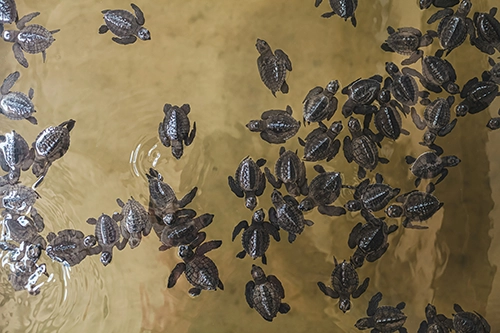
Global Warming and the Sea Turtle Gender Crisis: A Race Against Time
🐢 Global Warming and the Sea Turtle Gender Crisis: A Race Against Time
Global Warming and the Sea Turtle Gender Crisis: A Race Against Time
Sea turtles, like their reptilian relatives such as alligators, don't rely on conventional sex chromosomes to determine their gender. Instead, they take a unique approach called temperature-dependent sex determination (TSD). Unfortunately, this distinctive method is now causing considerable concern due to the potential impact of global warming on the sex ratios of sea turtle populations. Rising temperatures might lead to a significant drop in male sea turtles, posing a serious threat to the survival of these species.
Rising Temperatures and Skewed Sex Ratios
Global warming is causing a crisis in sea turtle populations. For instance, recent studies show that over 99% of green sea turtles in the northern Great Barrier Reef are now born female, a result of increasing sand temperatures at nesting sites (Jensen et al., Current Biology, 2018). This trend is also significant among Florida's sea turtles, as the last four years have experienced some of the hottest summers in the state's history.
Researchers studying sea turtle hatchlings and their eggs in this region found an unsettling absence of male sea turtles during this period. The critical factor in this gender determination process is the temperature of the sand where the eggs are buried:
Below 81.86°F (27.7°C): Predominantly male hatchlings
Above 88.8°F (31°C): Predominantly female hatchlings
This skewed gender ratio not only threatens genetic diversity but also raises concerns about the potential decline in sea turtle populations due to challenges in successful breeding.
The Role of Multiple Paternity: A Glimmer of Hope?
Amidst this troubling scenario, a recent study offers a glimmer of hope. Since 2013, biologists collecting blood samples from hundreds of turtle hatchlings on Sanibel Island, Florida, made an intriguing discovery. DNA analysis revealed that male turtle DNA never appeared in the nests of more than one female. This suggests that females can mate multiple times and store sperm, laying eggs in different nests, each with a different father.
The study concluded that, on average, for every sea turtle mother, there are nearly three fathers, indicating a higher number of breeding males than previously assumed (Phillott & Godfrey, Biological Conservation, 2021). While this discovery is heartening, it does not address the core issue: the impact of rising temperatures on future male hatchling production.
Why This Matters: Conservation at a Crossroads
The reliance on TSD makes sea turtles particularly vulnerable to climate change. Increased sand temperatures not only feminize populations but also reduce hatching success rates. Scientists emphasize that while multiple paternity may temporarily support genetic diversity, it cannot compensate for the long-term decline in male turtles if warming trends continue (Hays et al., Nature Climate Change, 2017).
What Can Be Done?
Urgent measures are needed to counteract the impacts of global warming and tackle the adverse effects of temperature-induced sex imbalances in sea turtles. Conservation strategies include:
Shading Nesting Beaches: Using artificial shading or vegetation to lower sand temperatures.
Relocating Nests: Moving nests to cooler areas or hatcheries with controlled conditions.
Monitoring Climate Trends: Continuously tracking sand temperatures at key nesting sites.
Community Engagement: Educating coastal communities on the importance of sustainable practices.
While the discovery of multiple paternity provides some hope, it does not eliminate the threat posed by climate change. The resilience of sea turtle populations depends on proactive efforts to address the root cause of the crisis.
Sources: https://oceanservice.noaa.gov/.../temperature-dependent....
https://www.sciencenews.org/.../warming-ocean-water-sea...





